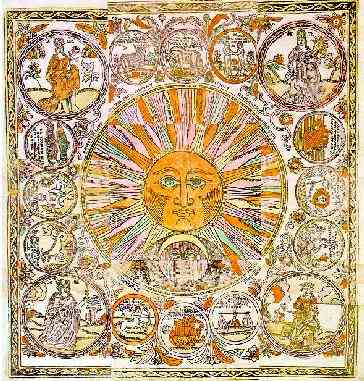
One of the earliest miscellaneous prints is the large lubok composed from several separate sheets, entitled The Sun and the Zodiac Signs. Scholars speculate that this print may show one of the ceilings in the legendary wooden palace of Aleksei Mikhailovich in Kolomenskoe. The large anthropomorphic sun and a smaller moon under it are in the middle of the composition, surrounded on four sides by three Zodiac signs with inscriptions. Between the Zodiac signs, in the four corners, are symbolic representations of the four seasons.
Completely different in style is The Hunter Stabs the Bear and the Dogs Bite, a simple illustration of a bear hunt, possibly used for educational purposes. Humbly I Ask, My Friend is an eighteenth-century birthday card; a mother and daughter offer their husband and father a glass of wine and plead with him to celebrate his birthday with them.
The Owl and The Eagle Owl are almost purely decorative prints which present the two birds without any explanatory text; like The Birds of Paradise and The Lyre-Tailed Meniur, they might have been originally copied from an illustration in a zoological atlas or nature book.
An interesting lubok from the second half of the nineteenth century shows Russian Christmas Divinations With Chickens. According to the print, the girls who want to find out about their future husbands place on the floor a mirror, a bowl with water, and a bowl with grain. Then each of them releases her chicken. If the chicken pecks at the mirror, the husband will be vain, if at the grain, he will be rich, and if it pecks at water, he will be a drunk.
Ivan Golyshev's studio in Mstera produced a funny "travel guide" to Moscow, the print Pantiushka and Sidorka See the Sights of Moscow, as well as a kind of an advertisement called Come and Get the Vladimir Cranberries, in which the seller entices the buyers by describing the surprising size and wonderful taste of Vladimir cranberries.
In the 1880s Golyshev was commissioned to engrave covers for The Fortune-Telling Book and The Dream Book. The Fortune-Telling Book was based on a popular principle of divination. The client (reader) took a grain of wheat and threw it on the large circle printed on the cover of the book. The circle was divided into sections, and each section contained a series of numbers. The predictions were read from the book according to the number on which the grain landed. The Dream Book explained the symbolic visions found in dreams and allowed the readers to interpret them.
Among the most amusing prints in this group are those which represent the topsy-turvy world, the world turned inside out, with reversed polarities. An excellent early sample is The Bull that Did Not Want to Be a Bull and Became a Butcher, a print which ponders what the world would look like if things were opposite to what they really are. In the middle of the print, which in its form resembles a hagiographical icon, unfolds the story of a bull who took bloody revenge on the butcher. Around the central image, thirteen smaller pictures with rhymed short inscriptions illustrate the impossible reversals: A sheep is shearing a shepherd, a peasant changes places with his judges, a donkey hits a heavily burdened peasant because he is going too slowly, children put an old man to bed and amuse him so he does not cry, a student beats the teacher who does not learn fast enough, a blind man leads the one who can see, a man is wearing hats on his feet and a shoe on his head, a stag runs away from a pig and a hunter from a hare, a parrot puts a man in a cage to make him speak, a donkey rides in a carriage drawn by women, a beggar gives alms to a rich man, a nobleman spins yarn while his wife is on guard duty; in the last picture a donkey is shaving a man and accidentally kicks him on the head.
A similar print, A Funny Little Folly for People to Be Jolly, depicting various animals burying a hunter, is a simple reworking of the famous How the Mice Buried the Cat, but with no political implications, and A Merry Ride in a Mouse-Drawn Carriage, which shows a cat and his lover riding in a carriage pulled by mice, can be considered a further exploitation of the same theme, but in this case the inscription contains an ominous, albeit camouflaged, warning against the omnipotence of the masters.